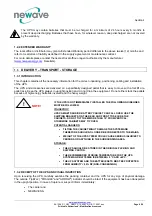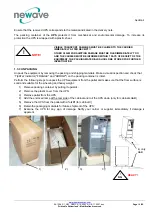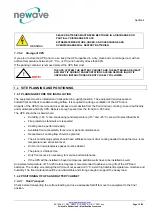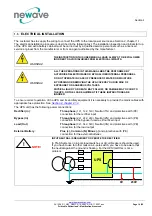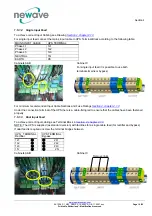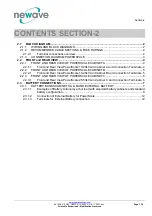
Section-1
www.newavenergy.com
04-1206_S1_NW_OPMPS_10-50kVA_GB_110201.doc
Page 6/20
Printed in Switzerland – Modifications reserved
1.2.3 MECHANICAL CHARACTERISTICS POWERSCALE 25-50KVA CABINET C
PowerScale Cabinet C
Max. Power connection
kVA
25
30
40
50
Dimensions (WxHxD)
mm
440x1400x910
Weight without battery
kg
(9Ah/28Ah)
151/135
(9Ah/28Ah)
160/145
9Ah/28Ah
165/150
9Ah/28Ah
170/155
Weight with battery
144 blocks of 7/9Ah
kg
540
550
555
560
48 blocks of 28Ah
kg
605
615
620
625
with standard packaging
kg
+ 5
Colour
Graffito grey (RAL 7024)
1.2.4 GENERAL SYSTEM DESCRIPTION
The UPS’s are used to protect sensitive equipment and prevent loss of valuable electronic information, minimise
equipment downtime, and minimise the adverse effect on production equipment due to unexpected power
problems.
The UPS system continually monitors incoming electrical power and removes the surges, spikes, sags, and other
irregularities that are inherent in commercial utility power. Working with a building‘s electrical system, the UPS
system supplies clean, consistent power that sensitive electronic equipment requires for reliable operation. During
brownouts, blackouts, and other power interruptions, batteries provide emergency power to safeguard operation.
The UPS system is housed in single freestanding cabinets. The cabinets line up and match in style and colour, and
have safety shields behind the doors for hazardous voltage protection.
1.2.4.1
Feature : Advanced-Booster Technology
Traditional input THD filters are no longer needed with this UPS product. The build-in advanced booster technology
of UPS modules provides perfect sinusoidal input power quality at 0.99 input power factor with harmonic content
less than 3% THD(i). This leads to more reliable total system operation and savings in generator and transformer
sizing as losses in the windings are minimised.
Due to the active front booster, regulating each individual phase, the UPS is comparable to a clean resistor load
(unity) from the mains perspective. Thus, the high input power factor provides minimised cabling and fusing costs
due to no reactive power consumption. The low harmonic currents are due to high input power factor and provide
the benefits:
•
No additional losses in wires and cables
•
No extra heating of transformers and generators with shortened service life

















